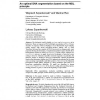Free Online Productivity Tools
i2Speak
i2Symbol
i2OCR
iTex2Img
iWeb2Print
iWeb2Shot
i2Type
iPdf2Split
iPdf2Merge
i2Bopomofo
i2Arabic
i2Style
i2Image
i2PDF
iLatex2Rtf
Sci2ools
CSB
2003
IEEE
2003
IEEE
An Optimal DNA Segmentation Based on the MDL Principle
: The biological world is highly stochastic and inhomogeneous in its behaviour. There are regions in DNA with high concentration of G or C bases; stretches of sequences with an abundance of CG dinucleotide (CpG islands); coding regions with strong periodicity-of-three pattern, and so forth. Transitions between these regions of DNA, known also as change points, carry important biological information. Computational methods used to identify these homogeneous regions are called segmentations. Viewing a DNA sequence as a non-stationary process, we apply recent novel techniques of universal source coding to discover stationary (possibly recurrent) segments. In particular, the Stein-Ziv lemma is adopted to find an asymptotically optimal discriminant function that determines whether two DNA segments are generated by the same source assuring exponentially small false positives. Next, we use the Minimum Description Length (MDL) principle to select parameters that leads to a linear-time segmentat...
| Added | 04 Jul 2010 |
| Updated | 04 Jul 2010 |
| Type | Conference |
| Year | 2003 |
| Where | CSB |
| Authors | Wojciech Szpankowski, Wenhui Ren, Lukasz Szpankowski |
Comments (0)

